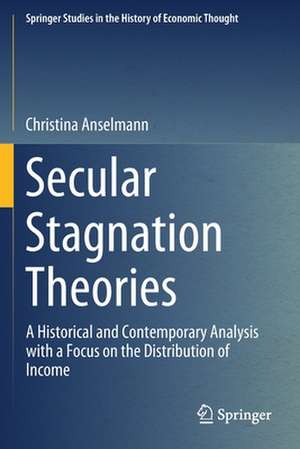Secular Stagnation Theories: A Historical and Contemporary Analysis with a Focus on the Distribution of Income: Springer Studies in the History of Economic Thought
Autor Christina Anselmannen Limba Engleză Paperback – 18 apr 2021
| Toate formatele și edițiile | Preț | Express |
|---|---|---|
| Paperback (1) | 699.59 lei 6-8 săpt. | |
| Springer International Publishing – 18 apr 2021 | 699.59 lei 6-8 săpt. | |
| Hardback (1) | 705.83 lei 6-8 săpt. | |
| Springer International Publishing – 18 apr 2020 | 705.83 lei 6-8 săpt. |
Preț: 699.59 lei
Preț vechi: 823.05 lei
-15% Nou
Puncte Express: 1049
Preț estimativ în valută:
133.88€ • 145.38$ • 112.46£
133.88€ • 145.38$ • 112.46£
Carte tipărită la comandă
Livrare economică 23 aprilie-07 mai
Preluare comenzi: 021 569.72.76
Specificații
ISBN-13: 9783030410896
ISBN-10: 3030410897
Ilustrații: XXI, 327 p. 45 illus.
Dimensiuni: 155 x 235 mm
Greutate: 0.49 kg
Ediția:1st ed. 2020
Editura: Springer International Publishing
Colecția Springer
Seria Springer Studies in the History of Economic Thought
Locul publicării:Cham, Switzerland
ISBN-10: 3030410897
Ilustrații: XXI, 327 p. 45 illus.
Dimensiuni: 155 x 235 mm
Greutate: 0.49 kg
Ediția:1st ed. 2020
Editura: Springer International Publishing
Colecția Springer
Seria Springer Studies in the History of Economic Thought
Locul publicării:Cham, Switzerland
Cuprins
Part I Secular Stagnation Theories: Past and Present.- Part II Income Distribution and Secular Stagnation.
Notă biografică
Christina Anselmann studied International Management at the Karlsruhe University of Applied Sciences (Germany), graduating with a master’s degree. She subsequently pursued a doctorate in Economics at the University of Hohenheim (Germany), which she successfully completed in 2019.
Textul de pe ultima copertă
In light of weak economic performances and rising income disparities across the developed world during the past decades, this book provides a comprehensive overview of secular stagnation theories in the history of economic thought and examines the role of income distribution in various stagnation hypotheses. By offering a historical perspective, from the classical economists to the most recent stagnation debate of the early twenty-first century, the author shows that most stagnation theories were developed in periods of high and/or rising income disparities. Eventually, it was Josef Steindl, one of the least recognized stagnationists in the history of economic thought, who put the distribution of income at the heart of his stagnation theory. While Josef Steindl focused on the nexus between the functional distribution of income and economic growth, this book includes the personal distribution of income in a Kaleckian-Steindlian model of economic growth and stagnation. In the model presented, the nexus between economic growth and the distribution of income is a priori uncertain, depending on the type of economic shock and the specific economic circumstances. The author also discusses various empirically oriented policy implications aimed at fostering both economic growth and a more equal distribution of income. This book appeals to scholars in economics and the history of economic thought interested in economic growth, secular stagnation, and income distribution.
Caracteristici
Provides a critical overview of secular stagnation theories from the classical economists to the most recent stagnation debate Examines the role of income distribution in various secular stagnation theories Incorporates the personal distribution of income in a Kaleckian-Steindlian model of economic growth and secular stagnation











